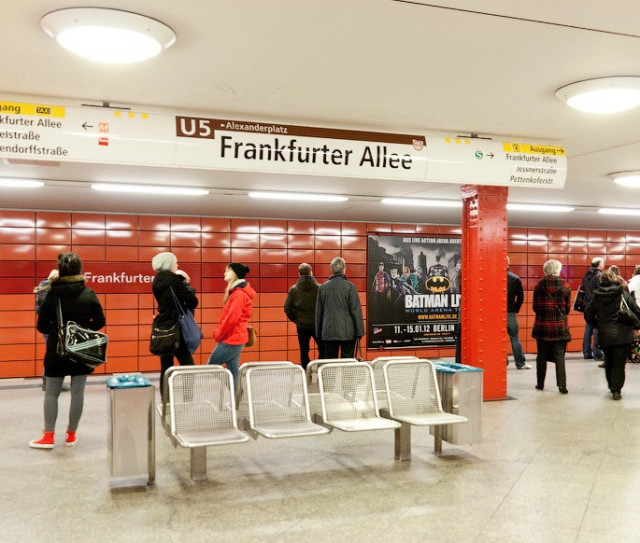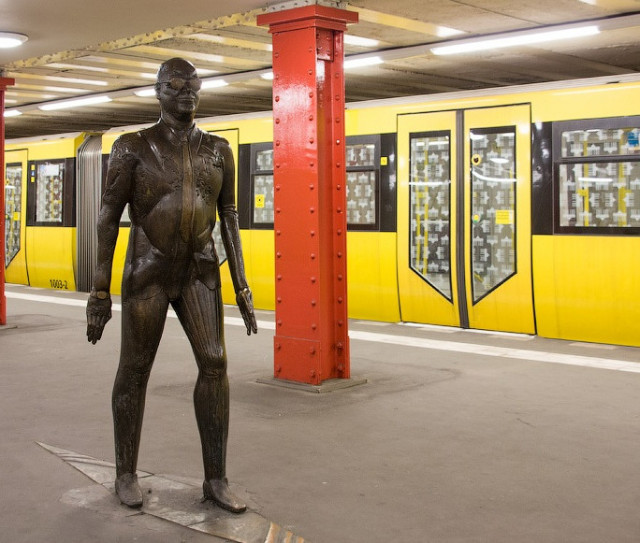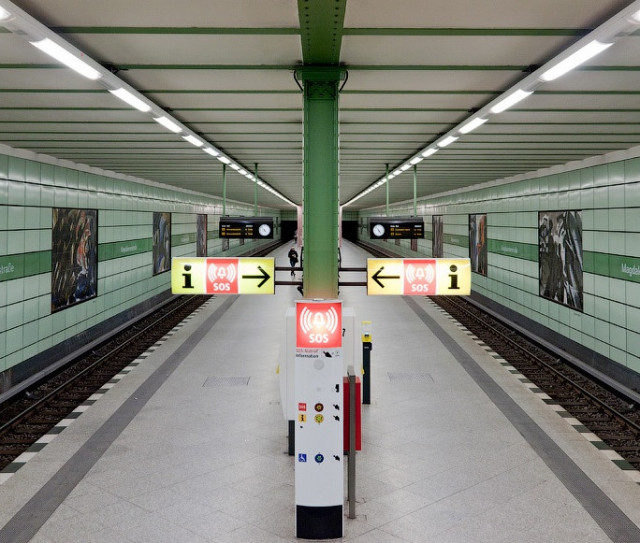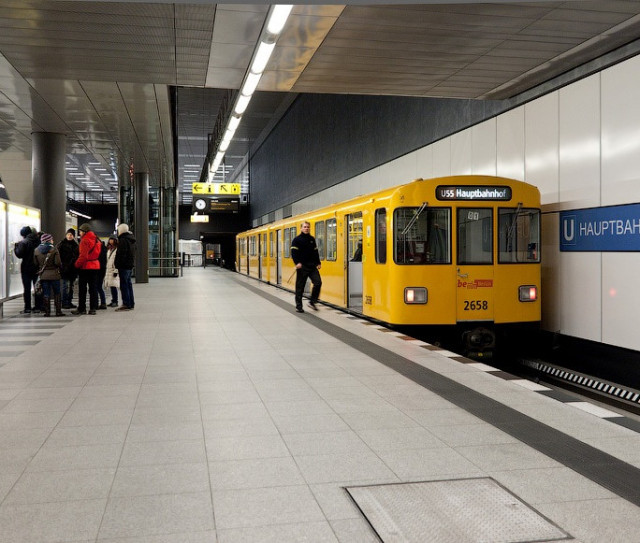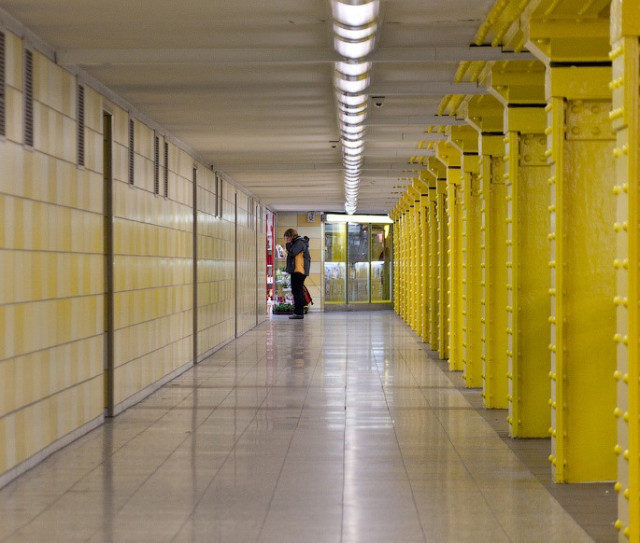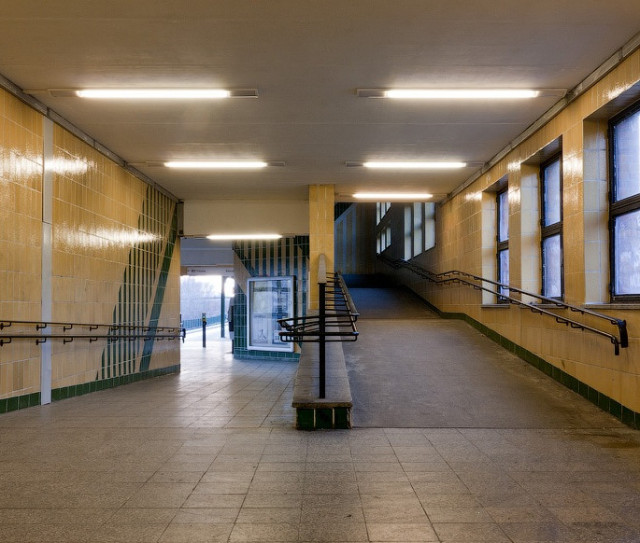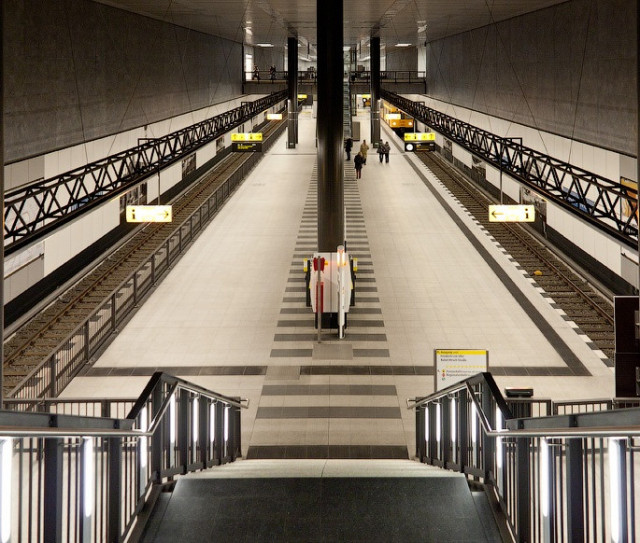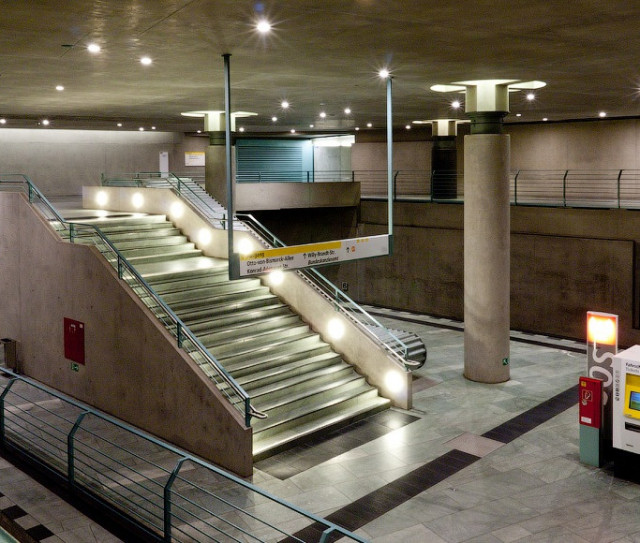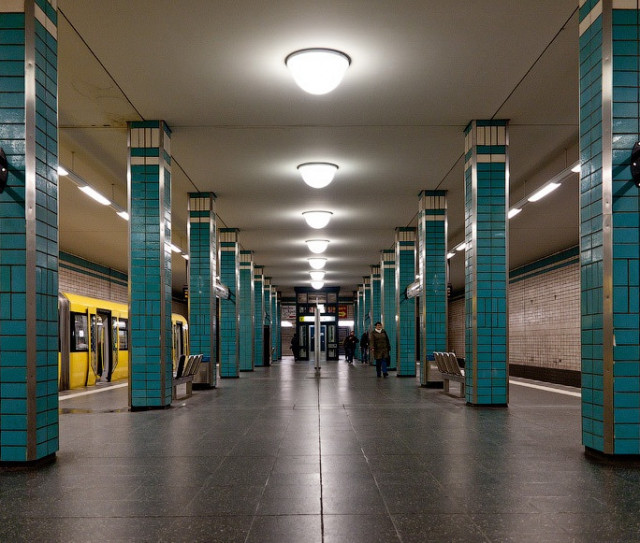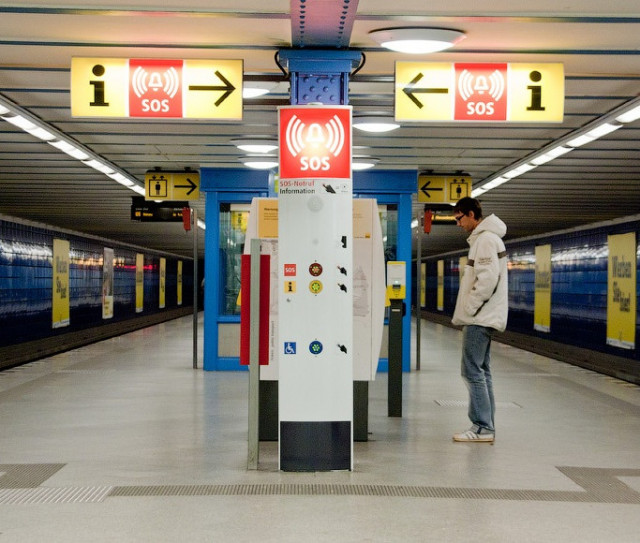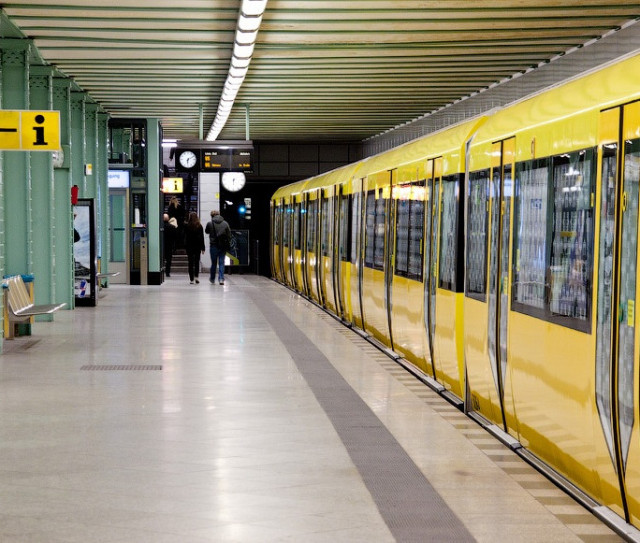- Linie U1
- Warschauer Str.
- Schlesisches Tor
- Görlitzer Bahnhof
- Kottbusser Tor
- Prinzenstr.
- Hallesches Tor
- Möckernbrücke
- Gleisdreieck
- Kurfürstenstr.
- Nollendorfpl.
- Wittenbergplatz
- Kurfürstendamm
- Uhlandstr.
- Linie U2
- Pankow
- Vinetastr.
- Schönhauser Allee
- Eberswalder Str.
- Senefelderplatz
- Rosa-Luxemburg-Platz
- Alexanderplatz
- Klosterstr.
- Märkisches Museum
- Spittelmarkt
- Hausvogteipl.
- Stadtmitte
- Mohrenstr.
- Potsdamer Platz
- Mendelssohn Bartholdy-Park
- Gleisdreieck
- Bülowstr.
- Nollendorfpl.
- Wittenbergplatz
- Zoologischer Garten
- Ernst-Reuter Platz
- Deutsche Oper
- Bismarckstr.
- Sophie- Charlotte-Platz
- Kaiserdamm
- Theodor-Heuss-Platz
- Neu-Westend
- Olympia-Stadion
- Ruhleben
- Linie U3
- Warschauer Str.
- Schlesisches Tor
- Görlitzer Bahnhof
- Kottbusser Tor
- Prinzenstr.
- Hallesches Tor
- Möckernbrücke
- Gleisdreieck
- Kurfürstenstr.
- Nollendorfpl.
- Wittenbergplatz
- Augsburger Str.
- Spichernstr.
- Hohenzollernpl.
- Fehrbelliner Platz
- Heidelberger Platz
- Rüdesheimer Platz
- Breitenbachplatz
- U Podbielskiallee (Berlin)
- Dahlem-Dorf
- Thielplatz
- Oskar-Helene-Heim
- Onkel Toms Hütte
- Krumme Lanke
- Linie U4
- Nollendorfpl.
- Viktoria-Luise- Platz
- Bayerischer Platz
- Rathaus Schöneberg
- Innsbrucker Platz
- Linie U5
- Hauptbahnhof
- Bundestag
- Brandenburger Tor
- Unter den Linden
- Museumsinsel
- Rotes Rathaus
- Alexanderplatz
- Schillingstr.
- Strausberger Platz
- Weberwiese
- Frankfurter Tor
- Samariterstr.
- Frankfurter Allee
- Magdalenenstr.
- Lichtenberg
- Friedrichsfelde
- Tierpark
- Biesdorf-Süd
- Elsterwerdaer Platz
- Wuhletal
- Kaulsdorf-Nord
- Kienberg
- Cottbusser Platz
- Hellersdorf
- Louis-Lewin Str.
- Hönow
- Linie U6
- Alt-Tegel
- Borsigwerke
- Holzhauser Str.
- Otisstraße
- Scharnweberstr.
- Kurt-Schumacher-Platz
- Afrikanische Str.
- Rehberge
- Seestr.
- Leopoldplatz
- Wedding
- Reinickendorfer Str.
- Schwartzkopffstr.
- Naturkundemuseum
- Oranienburger Tor
- Friedrichstraße
- Unter den Linden
- Stadtmitte
- Kochstr.
- Hallesches Tor
- Mehringdamm
- Platz der Luftbrücke
- Paradestr.
- Tempelhof
- Alt-Tempelhof
- Kaiserin-Augusta-Str.
- Ullsteinstr.
- Westphalweg
- Alt-Mariendorf
- Linie U7
- Rathaus Spandau
- Altstadt Spandau
- Zitadelle
- Haselhorst
- Paulsternstr.
- Rohrdamm
- Siemensdamm
- Halemweg
- Jakob-Kaiser-Platz
- Jungfernheide
- Mierendorffplatz
- Richard-Wagner Platz
- Bismarckstr.
- Wilmersdorfer Str.
- Adenauerplatz
- Konstanzer Str.
- Fehrbelliner Platz
- Blissestr.
- Berliner Str.
- Bayerischer Platz
- Eisenacher Str.
- Kleistpark
- Yorckstr.
- Möckernbrücke
- Mehringdamm
- Gneisenaustr.
- Südstern
- Hermannplatz
- Rathaus Neukölln
- Karl-Marx-Str.
- Neukölln
- Grenzallee
- Blaschkoallee
- Parchimer Allee
- Britz-Süd
- Johannisthaler Chaussee
- Lipschitzallee
- Wutzkyallee
- Zwickauer Damm
- Rudow
- Linie U8
- Wittenau
- Rathaus Reinickendorf
- Karl-Bonhoeffer- Nervenklinik
- Lindauer Allee
- Paracelsus Bad
- Residenzstr.
- Franz-Neumann- Platz
- Osloer Str.
- Pankstr.
- Gesundbrunnen
- Voltastr.
- Bernauer Str.
- Rosenthaler Platz
- Weinmeisterstr.
- Alexanderplatz
- Jannowitzbrücke
- Heinrich- Heine-Str.
- Moritzplatz
- Kottbusser Tor
- Schönleinstr.
- Hermannplatz
- Boddinstr.
- Leinestr.
- Hermannstr.
- Linie U9
- Osloer Str.
- Nauener Platz
- Leopoldplatz
- Amrumer Str.
- Westhafen
- Birkenstr.
- Turmstr.
- Hansaplatz
- Zoologischer Garten
- Kurfürstendamm
- Spichernstr.
- Güntzelstr.
- Berliner Str.
- Bundesplatz
- Friedrich-Wilhelm- Platz
- Walther-Schreiber- Platz
- Schloßstr.
- Rathaus Steglitz
- No matches
- Linie U1
- Warschauer Str.
- Schlesisches Tor
- Görlitzer Bahnhof
- Kottbusser Tor
- Prinzenstr.
- Hallesches Tor
- Möckernbrücke
- Gleisdreieck
- Kurfürstenstr.
- Nollendorfpl.
- Wittenbergplatz
- Kurfürstendamm
- Uhlandstr.
- Linie U2
- Pankow
- Vinetastr.
- Schönhauser Allee
- Eberswalder Str.
- Senefelderplatz
- Rosa-Luxemburg-Platz
- Alexanderplatz
- Klosterstr.
- Märkisches Museum
- Spittelmarkt
- Hausvogteipl.
- Stadtmitte
- Mohrenstr.
- Potsdamer Platz
- Mendelssohn Bartholdy-Park
- Gleisdreieck
- Bülowstr.
- Nollendorfpl.
- Wittenbergplatz
- Zoologischer Garten
- Ernst-Reuter Platz
- Deutsche Oper
- Bismarckstr.
- Sophie- Charlotte-Platz
- Kaiserdamm
- Theodor-Heuss-Platz
- Neu-Westend
- Olympia-Stadion
- Ruhleben
- Linie U3
- Warschauer Str.
- Schlesisches Tor
- Görlitzer Bahnhof
- Kottbusser Tor
- Prinzenstr.
- Hallesches Tor
- Möckernbrücke
- Gleisdreieck
- Kurfürstenstr.
- Nollendorfpl.
- Wittenbergplatz
- Augsburger Str.
- Spichernstr.
- Hohenzollernpl.
- Fehrbelliner Platz
- Heidelberger Platz
- Rüdesheimer Platz
- Breitenbachplatz
- U Podbielskiallee (Berlin)
- Dahlem-Dorf
- Thielplatz
- Oskar-Helene-Heim
- Onkel Toms Hütte
- Krumme Lanke
- Linie U4
- Nollendorfpl.
- Viktoria-Luise- Platz
- Bayerischer Platz
- Rathaus Schöneberg
- Innsbrucker Platz
- Linie U5
- Hauptbahnhof
- Bundestag
- Brandenburger Tor
- Unter den Linden
- Museumsinsel
- Rotes Rathaus
- Alexanderplatz
- Schillingstr.
- Strausberger Platz
- Weberwiese
- Frankfurter Tor
- Samariterstr.
- Frankfurter Allee
- Magdalenenstr.
- Lichtenberg
- Friedrichsfelde
- Tierpark
- Biesdorf-Süd
- Elsterwerdaer Platz
- Wuhletal
- Kaulsdorf-Nord
- Kienberg
- Cottbusser Platz
- Hellersdorf
- Louis-Lewin Str.
- Hönow
- Linie U6
- Alt-Tegel
- Borsigwerke
- Holzhauser Str.
- Otisstraße
- Scharnweberstr.
- Kurt-Schumacher-Platz
- Afrikanische Str.
- Rehberge
- Seestr.
- Leopoldplatz
- Wedding
- Reinickendorfer Str.
- Schwartzkopffstr.
- Naturkundemuseum
- Oranienburger Tor
- Friedrichstraße
- Unter den Linden
- Stadtmitte
- Kochstr.
- Hallesches Tor
- Mehringdamm
- Platz der Luftbrücke
- Paradestr.
- Tempelhof
- Alt-Tempelhof
- Kaiserin-Augusta-Str.
- Ullsteinstr.
- Westphalweg
- Alt-Mariendorf
- Linie U7
- Rathaus Spandau
- Altstadt Spandau
- Zitadelle
- Haselhorst
- Paulsternstr.
- Rohrdamm
- Siemensdamm
- Halemweg
- Jakob-Kaiser-Platz
- Jungfernheide
- Mierendorffplatz
- Richard-Wagner Platz
- Bismarckstr.
- Wilmersdorfer Str.
- Adenauerplatz
- Konstanzer Str.
- Fehrbelliner Platz
- Blissestr.
- Berliner Str.
- Bayerischer Platz
- Eisenacher Str.
- Kleistpark
- Yorckstr.
- Möckernbrücke
- Mehringdamm
- Gneisenaustr.
- Südstern
- Hermannplatz
- Rathaus Neukölln
- Karl-Marx-Str.
- Neukölln
- Grenzallee
- Blaschkoallee
- Parchimer Allee
- Britz-Süd
- Johannisthaler Chaussee
- Lipschitzallee
- Wutzkyallee
- Zwickauer Damm
- Rudow
- Linie U8
- Wittenau
- Rathaus Reinickendorf
- Karl-Bonhoeffer- Nervenklinik
- Lindauer Allee
- Paracelsus Bad
- Residenzstr.
- Franz-Neumann- Platz
- Osloer Str.
- Pankstr.
- Gesundbrunnen
- Voltastr.
- Bernauer Str.
- Rosenthaler Platz
- Weinmeisterstr.
- Alexanderplatz
- Jannowitzbrücke
- Heinrich- Heine-Str.
- Moritzplatz
- Kottbusser Tor
- Schönleinstr.
- Hermannplatz
- Boddinstr.
- Leinestr.
- Hermannstr.
- Linie U9
- Osloer Str.
- Nauener Platz
- Leopoldplatz
- Amrumer Str.
- Westhafen
- Birkenstr.
- Turmstr.
- Hansaplatz
- Zoologischer Garten
- Kurfürstendamm
- Spichernstr.
- Güntzelstr.
- Berliner Str.
- Bundesplatz
- Friedrich-Wilhelm- Platz
- Walther-Schreiber- Platz
- Schloßstr.
- Rathaus Steglitz
- No matches
Copyright © 2025 Discover Ukraine LLC.
Info
The Berlin Metro, also known as U-Bahn Berlin, stands as one of Europe's oldest subways and Germany's very first, commencing operations in 1902. The debut line of the Berlin subway was constructed above ground on cast-iron viaducts, linking Postdamer Platz with the eastern bank of the Spree River through the iconic Oberbaumbrücke bridge. The renowned German engineer and inventor Werner von Siemens, founder of the eponymous company, played a pivotal role in its design.
Today, the Berlin metro network encompasses nine subterranean lines, catering to a daily ridership of around 1.5 million passengers. The extensive coverage of Berlin metro stations spans from the city center to the outskirts, granting convenient access to landmarks like Charlottenburg Castle (Schloss Charlottenburg) and the Brandenburg Gate (Brandenburger Tor). While Schönefeld Airport (Flughafen Berlin-Schönefeld) necessitates a transfer to a suburban train, Tegel Airport (Flughafen Berlin-Tegel) can be reached via bus from the Kurt-Schumacher-Platz underground station. Notably, further metro expansions are planned, primarily in the western sectors of the city.
Administered by BVG, the public transportation company, the Berlin metro operates alongside buses, trams, and boats. Collectively with the S-Bahn Berlin (suburban train lines), they compose the core of public transit within the German capital. Berlin's transport network is categorized into three fare zones: city center (A), outskirts (B), and suburbs (C). The Berlin Underground is situated within zones A and B. A fare for the Berlin Underground amounts to 3.20 EUR, valid for a two-hour window across all public transport modes.
Distinctively, turnstiles are absent from the Berlin metro stations. Procured tickets necessitate validation and preservation for the duration of the journey, as inspections are frequently conducted. The penalty for traveling without a ticket on Berlin's public transport stands at 60 EUR. The station interiors are predominantly adorned with functional elements in dark tones, underscoring the metro's utilitarian convenience over ornate aesthetics. Furthermore, seamless telephone connectivity is available throughout the Berlin underground.
Station platforms often accommodate multiple directions, warranting passengers to carefully observe the train's intended route. Access to train cars is facilitated by buttons on both sides of each door.
Lines
Berlin Metro accounts for 175 stations, situated on nine lines. The lines have their own color and letter designations: U1 (green), U2 (red), U3 (turquoise), U4 (yellow), U5 (brown), U6 (purple), U7 (baby blue), U8 (blue), and U9 (orange). Total lines length amounts to 155 km. Hours of service: 4from 4 a.m. till 1 a.m. on week days. Moreover, the metro runs all night at the weekend. The lines are closely intertwined with other kinds of public transport, which makes it possible to make a transfer at many stations.
Fare
Metro is divided into zones, influencing the cost of travel. A single ticket in AB zone (centre and surrounding areas) costs 3,20 EUR, in BC zone (vicinage and suburbs) – 3,80 EUR, the entire ABC zone – 4,00 EUR. A ticket is valid for two hours in all kinds of public transport. Moreover, there are tickets for three stops costing 2,20 EUR, for one day – 9,50 EUR, for 7 days – 39,00 EUR. One-day group ticket for five people costing 29,00 EUR is also available. Children under 6 can use the Berlin Underground for free. Children from 6 to 14 years old are offered special discounted rates.
Ticketing
Tickets are available in terminals, located at metro stations, and on board of trams and buses. You can pay either with card or with cash. Acquired ticket should be validated in a machine, situated next to a ticket terminal. A ticket is validated with a stamp, indicating date, time and station of validation. There are no subway turnstiles in Berlin, and ticket inspection is carried out by controllers.
 English
English Deutsch
Deutsch Français
Français Italiano
Italiano Español
Español Português
Português Русский
Русский Українська
Українська Polski
Polski Čeština
Čeština Ελληνικά
Ελληνικά Türkçe
Türkçe Tiếng Việt
Tiếng Việt ไทย
ไทย 日本語
日本語 中文
中文 한국어
한국어
